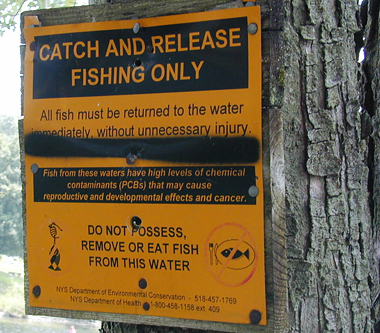Study Finds PCBs Disrupt Pregnancy
 |
|
Environmental toxicants such as PCBs -- which are found in fish and other animals in the Hudson and St. Lawrence Rivers -- can disrupt the reproductive cycle in women.
|
ALBANY, N.Y. (November 9, 2016) -- PCBs (polychlorinated biphenyls) and other environmental toxicants can disrupt the reproductive cycle in women, according to a new long-term study led by UAlbany researchers.
Working with the Akwesasne Mohawk Nation on the St. Lawrence River, researchers from UAlbany’s Center for the Elimination of Minority Health Disparities (CEHMD) studied the relationship between the menstrual cycles, conception and reproductive endpoints in Akwesasne women from 2009 through 2013.
Reporting in Environmental Research, the authors found that certain environmental toxicants such as PCBs may adversely affect menstrual cycles and thus have the capacity to impair reproductive function, including likelihood of conception.
"We found that the odds of women with detected levels of pollutants had a more than 30 percent relative risk of not ovulating during their menstrual cycle," said Mia Gallo, research assistant professor in anthropology and lead author of the study.
Further, for every unit increase in pollutants, women with detectable levels had over three times higher likelihood of not ovulating as compared to women with no detectable level. The researchers believe these findings should apply to all women in the U.S. with PCB exposure. In addition, obesity was a factor, with overweight and obese women having a smaller chance of ovulation.
The Akwesasne Mohawk Nation is situated on a territory adjoining New York, Ontario and Quebec. The land is in close proximity to three industrial sites known to have contaminated the area by discharging massive amounts of PCBs into the St. Lawrence River and its tributaries. The area is now home to one National Priority Superfund site and two New York State Superfund sites. The pollution of the local waters has led to some local species of fish, birds, amphibians and mammals to have toxicant levels exceeding the U.S. Food and Drug Administration’s tolerance limits for human consumption.
Members of the Mohawk Nation of Akwesasne had concerns as far back as the early 1980s regarding the health impact of exposure to these contaminants. Additionally, health providers for the Nation have for a number of years reported that women have had trouble conceiving and suffered many miscarriages. CEMHD previously led a study on how PCB exposure in Akwesasne girls has altered the rate of sexual maturation and the onset of menstruation.
"While there are a few studies on the impact of environmental pollutants on menstrual cycle length, to our knowledge there is no other study of the relationship of PCBs and human ovulatory status in the literature," said CEMHD director Lawrence Schell, who is also a professor of anthropology and epidemiology and biostatistics.
CEMHD was established in 2004 through a three-year, $1.24 million grant from the NIH and endorsed by the New York State Department of Health (NYSDOH). A collaborative effort focusing on minority health disparities in the smaller cities and towns of New York, it works to eliminate health disparities by developing capacity in faculty at the University and partnering with community groups to identify their health concerns and the sources of disparities, and then plan, implement and test strategies to alleviate them.
The Center is currently spearheading a $10 million initiative through a National Institutes of Health endowment grant to address the future of minority health disparities in the Northeastern U.S.
![]() For more news, subscribe to UAlbany's RSS headline feeds
For more news, subscribe to UAlbany's RSS headline feeds
A comprehensive public research university, the University at Albany-SUNY offers more than 120 undergraduate majors and minors and 125 master's, doctoral and graduate certificate programs. UAlbany is a leader among all New York State colleges and universities in such diverse fields as atmospheric and environmental sciences, business, education, public health,health sciences, criminal justice, emergency preparedness, engineering and applied sciences, informatics, public administration, social welfare and sociology, taught by an extensive roster of faculty experts. It also offers expanded academic and research opportunities for students through an affiliation with Albany Law School. With a curriculum enhanced by 600 study-abroad opportunities, UAlbany launches great careers.


